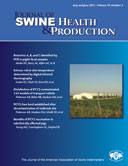Abstract:

Establishment and maintenance of a porcine circovirus type 2 (PCV2)-free breeding herd on a site that experienced a natural outbreak of PCV2-associated reproductive disease
Abby R. Patterson, DVM, MS, PhD; Darin M. Madson, DVM, PhD; Shayleen D. Schalk, BS; Patrick G. Halbur, DVM, MS, PhD; Tanja Opriessnig, Dr med vet, PhD
Complete article is available online.
PDF version is available online.
An outbreak of reproductive failure associated with porcine circovirus type 2 (PCV2) occurred in a closed, PCV2-naive, specific-pathogen-free herd in Iowa in 2009. Elimination of infectious PCV2 from the breeding-herd site, the outcome after repopulation, and the attempt to derive PCV2-negative animals by offsite segregation are summarized. Clinical signs were limited to an increased incidence of mummified fetuses. After confirmation of PCV2-associated lesions in the fetuses and PCV2 viremia in dams, the herd was depopulated. Cleaning and disinfection of the premises prior to repopulation included removal of gross organic material, exposure of equipment to natural UV light, multiple applications of disinfectant, and application of paint or sealer to porous surfaces. During the 63-day clean-up period, no pigs were on the site. An improved biosecurity plan was implemented. The herd was repopulated and a PCV2-naive population had remained PCV2-negative for 20 months at the time of writing. Attempts to derive PCV2-negative pigs from the positive herd following offsite segregation were unsuccessful. The combination of a multistep cleaning and disinfection protocol with a strict biosecurity plan can result in the maintenance of PCV2-naive animals on a previously contaminated site.
Keywords: porcine circovirus type 2, disinfection, biosecurity, PCV2, case report
![]() Cite as: Patterson AR, Madson DM, Schalk SD, et al. Establishment and maintenance of a porcine circovirus type 2 (PCV2)-free breeding herd on a site that experienced a natural outbreak of PCV2-associated reproductive disease. J Swine Health Prod 2011;19(3):165-174.
Cite as: Patterson AR, Madson DM, Schalk SD, et al. Establishment and maintenance of a porcine circovirus type 2 (PCV2)-free breeding herd on a site that experienced a natural outbreak of PCV2-associated reproductive disease. J Swine Health Prod 2011;19(3):165-174.
Search the AASV web site for pages with similar keywords.
